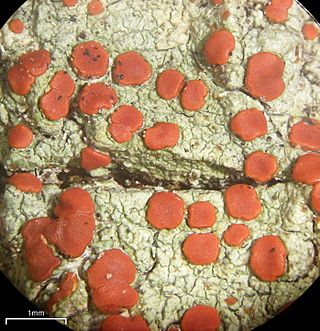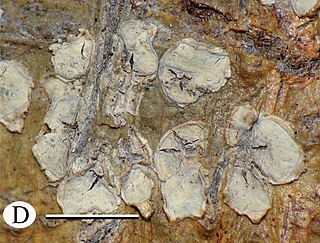
The Cladoniaceae are a family of lichenized fungi in the order Lecanorales. It is one of the largest families of lichen-forming fungi, with about 560 species distributed amongst 17 genera. The reindeer moss and cup lichens (Cladonia) belong to this family. The latter genus, which comprises about 500 species, forms a major part of the diet of large mammals in taiga and tundra ecosystems. Many Cladoniaceae lichens grow on soil, but other can use decaying wood, tree trunks, and, in a few instances, rocks as their substrate. They grow in places with high humidity, and cannot tolerate aridity.

The Graphidaceae are a family of lichen-forming fungi in the order Graphidales. The family contains nearly a hundred genera and more than 2000 species. Although the family has a cosmopolitan distribution, most Graphidaceae species occur in tropical regions, and typically grow on bark.

Ramboldia is a genus of lichen-forming fungi in the family Ramboldiaceae. The genus was circumscribed in 1994 by Gintaras Kantvilas and John Alan Elix. It was emended in 2008 by the inclusion of Pyrrhospora species containing the anthraquinone russulone in their apothecia and having a prosoplectenchymatous exciple. The family Ramboldiaceae was circumscribed in 2014 to contain the genus.
Teuvo ("Ted") Tapio Ahti is a Finnish botanist and lichenologist. He has had a long career at the University of Helsinki that started in 1963, and then following his retirement in 1997, at the Botanical Museum of the Finnish Museum of Natural History. Known as a specialist of the lichen family Cladoniaceae, Ahti has published more than 280 scientific publications. A Festschrift was dedicated to him in 1994, and in 2000 he was awarded the prestigious Acharius Medal for lifetime contributions to lichenology.
Cladia beaugleholei is a lichen in the family Cladoniaceae, found in Australia. It was first described as Heterodea beaugleholei in 1978 by Rex Filson, from a specimen collected from forest soil in New South Wales. The species epithet honours Alexander Clifford Beauglehole. It was reassigned to the genus, Cladia by Sittiporn Parnmen and H. Thorsten Lumbsch in 2012.
Rexiella is a lichen genus in the family Cladoniaceae. The genus, originally circumscribed with the name Rexia by authors Soili Stenroos, Raquel Pino-Bodas, and Teuvo Ahti in 2018, was created to contain the species Cladonia sullivanii, first formally described in 1882 by Swiss botanist Johannes Müller Argoviensis. After publication of the new genus, it was discovered that the name was illegitimate, because an earlier homonym had been published; the generic name RexiaD.A.Casamatta, S.R.Gomez & J.R.Johansen had already been created in 2006 to contain the cyanobacterial species Rexia erecta. The new name Rexiella was therefore proposed in 2019. This name honours the Australian lichenologist Rex Filson, who published monographs on the genera Cladia and Heterodea.

Pulchrocladia is a genus of fruticose lichens in the family Cladoniaceae. It has three species. The genus was circumscribed in 2018 by lichenologists Soili Stenroos, Raquel Pino-Bodas, Helge Thorsten Lumbsch, and Teuvo Ahti. The genus name refers to "the beautiful morphology of its species".

Astrochapsa is a genus of lichen-forming fungi in the subfamily Graphidoideae of the family Graphidaceae. It has 28 species. The genus was circumscribed by Sittiporn Parnmen, Robert Lücking, and H. Thorsten Lumbsch in 2012, with Astrochapsa astroidea assigned as the type species. It was segregated from the genus Chapsa, from which it differs in having a more frequently densely corticate thallus, an apothecial margin that is mostly recurved, and the almost exclusively subdistoseptate, non-amyloid ascospores.

Megalospora is a genus of lichen-forming fungi in the family Megalosporaceae.

Pulchrocladia retipora, most commonly known as the coral lichen, is a species of fruticose lichen in the family Cladoniaceae. It occurs in Australasia and New Caledonia where it grows in coastal and alpine heathlands. The lichen features coral-like branches and subbranches with numerous netlike perforations. It is known by multiple names, with some sources referring to it by its synonym Cladia retipora, or the common name lace lichen.
Pulchrocladia corallaizon is a species of lichen in the family Cladoniaceae. It was first formally described as Cladia corallaizon. The specific epithet corallaizon, modified from Greek, means "ever-living coral". In 2018, it was transferred to the newly circumscribed genus Pulchrocladia.
Pulchrocladia ferdinandii is a species of lichen in the family Cladoniaceae. It was first formally described as Cladonia ferdinandii by Swiss lichenologist Johannes Müller Argoviensis in 1882. The specific epithet honours German-Australian botanist Ferdinand von Mueller, who collected the type specimen near Esperance, Western Australia. Rex Filson transferred the taxon to Cladia in 1970. In 2018, it was transferred to the newly circumscribed genus Pulchrocladia.
Cameronia is a genus of crustose lichens in the monotypic family Cameroniaceae. It has two species. Both the genus and its two species were described as new to science in 2011 by Australian lichenologist Gintaras Kantvilas. Characteristics of the genus include its chlorococcalean photobiont partner, and perithecioid ascomata that are deeply immersed in the substrate. Microscopic features of Cameronia include the four-spored asci with an intensely hemiamyloid outer wall and non-amyloid, well-developed tholus, and hyaline, muriform ascospores. Both species are endemic to the Tasmanian Highlands.

The Collematineae are an suborder of rust fungi in the order of Peltigerales in the class Lecanoromycetes.
Pertusaria archeri is a rare species of corticolous (bark-dwelling), crustose lichen in the family Pertusariaceae. Found in Thailand, it was formally described as a new species in 2005 by Sureeporn Jariangprasert. The type specimen was collected by the author from Doi Khun Tan National Park at an altitude of 1,010 m (3,310 ft), where it was found in an evergreen forest growing on the bark of Styrax. The species epithet honours Australian lichenologist Alan W. Archer, an authority of Pertusaria taxonomy. The main distinguishing characteristics of Pertusaria archeri are its two-spored asci, and the presence of depside methyl esters as lichen products.
Pertusaria bokluensis is a rare species of corticolous (bark-dwelling), crustose lichen in the family Pertusariaceae. Found in Thailand, it was formally described as a new species in 2005 by Sureeporn Jariangprasert. The type specimen was collected from the Bo Kluea Nhuea community at an altitude of 1,000 m (3,300 ft), where it was found growing on the bark of Dalbergia. It is only known from the type specimen. The species epithet combines the name of the type locality with the Latin adjective -ensis, meaning "place of origin". The main distinguishing characteristics of Pertusaria bokluensis are the eight-spored asci, and the presence of the lichen products 4,5-dichlorolichexanthone and 2,2'-di-O-methylstenosporic acid.
Pertusaria elixii is a rare species of corticolous (bark-dwelling), crustose lichen in the family Pertusariaceae. Found in Thailand, it was formally described as a new species in 2005 by Sureeporn Jariangprasert. The type specimen was collected by the author from Doi Inthanon National Park at an altitude of 1,900 m (6,200 ft), where it was found growing on Betula alnoides. The species epithet honours Australian lichenologist John Elix, who assisted the author in chemical analysis of lichen specimens. Pertusaria elixii is distinguished from related species by the number of ascospores in its ascus (four), and the presence of 2'-O-methyl-substituted homologues of perlatolic acid.
Pertusaria inthanonensis is a species of crustose lichen in the family Pertusariaceae. Found in northern and northeastern Thailand, it was formally described as a new species in 2005 by Sureeporn Jariangprasert. The type specimen was collected by the author from the Doi Inthanon National Park at an altitude of 1,900 m (6,200 ft), where it was found growing on the bark of a birch tree. The species epithet combines the name of the type locality with the Latin suffix ensis. The main distinguishing characteristics of the lichen are its asci that contain either two or four smooth ascospores, and the presence of confluentic acid, stictic acid, and lichexanthone. The latter substance causes the thallus to fluoresce a bright yellow colours when lit with a long-wavelength UV light.
Pertusaria krabiensis is a rare species of corticolous (bark-dwelling), crustose lichen in the family Pertusariaceae. Found in peninsular Thailand, it was formally described as a new species in 2005 by Sureeporn Jariangprasert. The type specimen was collected from near the Wat Thamp Suea Temple in Krabi; the species is known only from the type. The species epithet combines the name of the type locality with the Latin suffix -ensis. The main distinguishing characteristics of Pertusaria krabiensis are its uniseriate ascospores, and the presence of homologues of the lichen product 2-O-methylperlatolic acid.
Gintarasia is a genus of lichen-forming fungi in the family Graphidaceae. It has seven species, all of which are found in Australia. Gintarasia species are corticolous (bark-dwelling), crustose lichens with a thelotremoid form.








